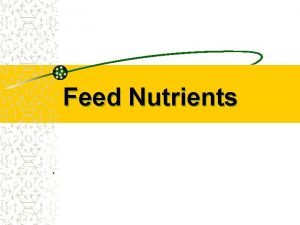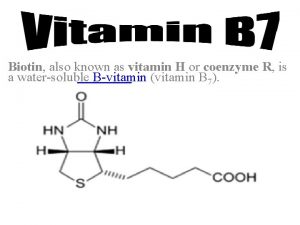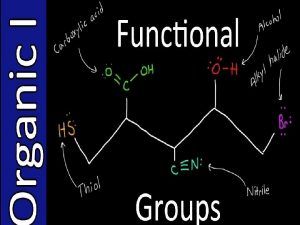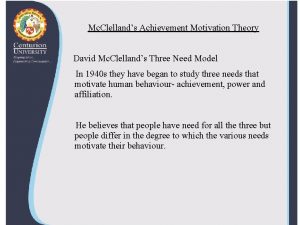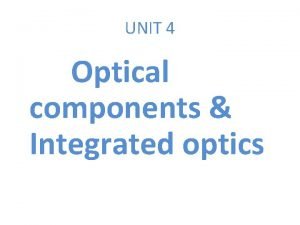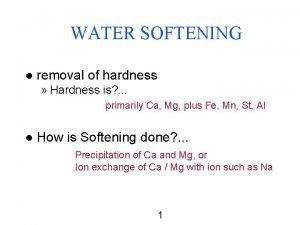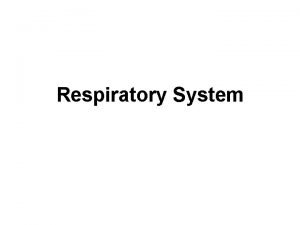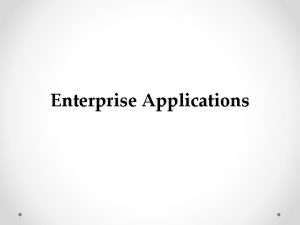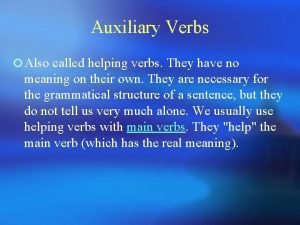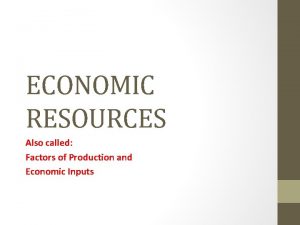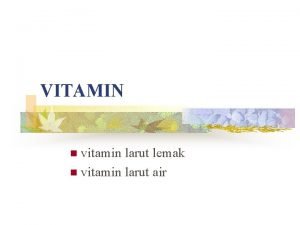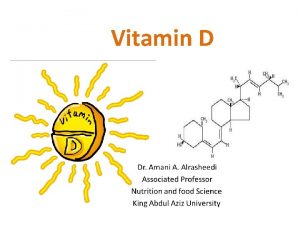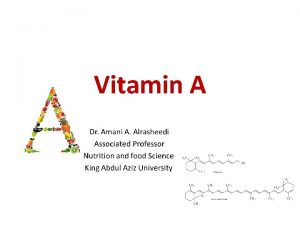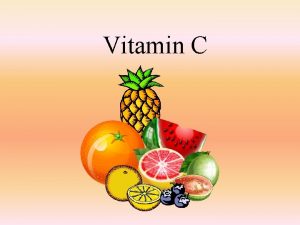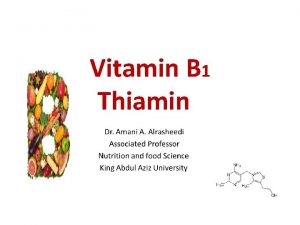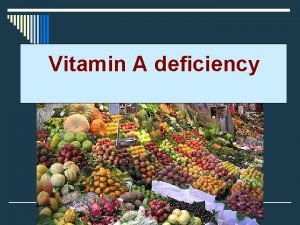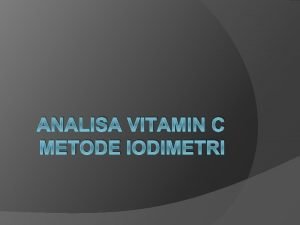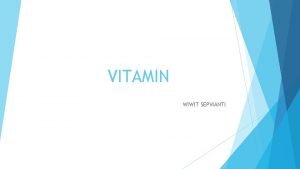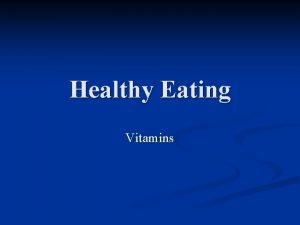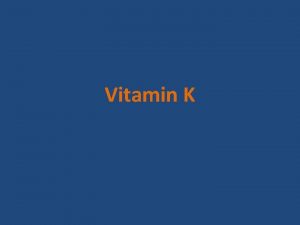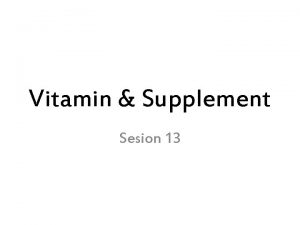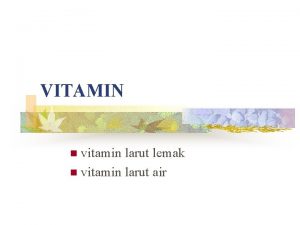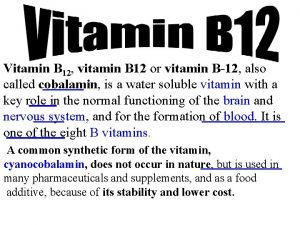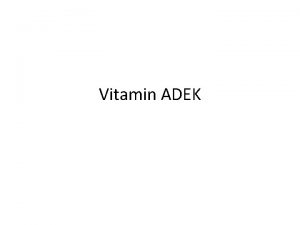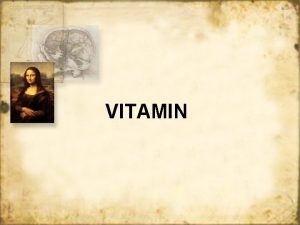3 Vitamin K Also called Antihemorrhagic vitamin Sources





















- Slides: 21

3) Vitamin K Ø Also called "Anti-hemorrhagic vitamin"

Ø Sources: 1) Vitamin K 1: presents in plants such as spinach, cauliflower, olive oil, Cotton seed oil & fish and liver. 2) Vitamin K 2: Synthesized by large intestinal bacteria. 3) Vitamin K 3: It is synthetic.

Ø Mechanism of action of vitamin K (vitamin K cycle): Ø Vitamin K involved in γ-carboxylation of glutamate residues of proteins leading to formation of γ-carboxy glutamate residue which is called Gal-residues which are: • Usually situated in specific protein domains called Gal domains. • Involved in calcium binding to mediate the effect of vitamin K.

Ø Biological actions of Vitamin K: 1) Blood coagulation: • The activation of some of the enzymes in the coagulation cascade is dependent on vitamin K. • Some oral anticoagulants like warfarin function according to this principle (block vitamin K function, resulting in decreased formation of clots). 2) Vitamin K promotes insulin sensitivity & regulation of blood glucose level: because it is involved in insulin secretion.

3) Bone metabolism: • Osteocalcin & matrix Gla proteins are vitamin K dependent bone proteins. • Osteocalcin is converted to its active form through vitamin K dependent γ-carboxylation of its glutamate residues. • Vitamin K binds to hydroxyapatite promoting bone mineralization. • Both osteocalcin & matrix Gla-proteins have high affinity to Ca 2+; control its movement, directing it to bone & teeth & prevent its deposition in the soft tissues including blood vessels & CNS.

4) Regulation of cell proliferation & differentiation 5) Anti- oxidant: which is more powerful than vitamin E. 6) Anti cancer effects through: • Modulation of several transcriptional factors involved in cancer. • Binds to cyclin dependent protein kinases "cd. Ks" → stoppage of cell cycle & death of cancer cells. 7) Treatment of Alzheimer's diseases due to its antioxidant properties. 8) Normal development of the nervous system.

8) It inhibits the production of interleukin-6 which is: • Pro-inflammatory cytokine. • Atherogenic: through stimulation of acute phase proteins production including the CRP (has atherogenic effect). • Suppress the reproductive function. 9) It is used as antidote for cauramine poisoning: Cauramine is rodenticidal (completely blocks vitamin K synthesis causing internal hemorrhage). 10) Vitamin K can be used topically to decrease: • Post-operative bruising, Varicose veins, Broken capillaries, hyperpigmentation & dark haloes around the eye.

Ø Vitamin K deficiency: o Aetiology: it is a rare condition due to its syntheses by bacterial flora, but occurs in the following conditions: 1) Newborn infants, as they have sterile intestine. 2) Long term use of dicumarol "anticoagulant" which compete with vitamin K for the site of action. 3) Long term use of antibiotics (kill the intestinal bacteria). 4) Liver diseases as the liver is the site of formation of both bile salts needed for vitamin K absorption & prothrombin "clotting factor II".

Ø Diseases of Vit K deficiency: 1) VKDB "Vit. K deficiency bleeding": • Occurs in the newborn infants (up to 6 months of age). So vitamin K prophylaxis is given to all newborns. 2) Heart attacks & strokes: • Vitamin K-dependent bone proteins prevent calcium deposition in the soft tissues such as blood vessels "especially arteries" so, vitamin K deficiency cause deposition of calcium in the arteriosclerosis→ heart attacks & strokes. arteries→

3) Osteoporosis & osteomalacia "decrease in the bone density & easy bone fracture". 4) Chronic neuronal hyperexcitment: • Manifested as autistic symptoms due to uncontrolled calcium movement which lead to uncontrolled neuronal firing. Ø Requirements: No dietary requirements except in the conditions that cause vitamin K deficiency.

4) Vitamin E Ø Also called "Anti-sterility vitamin, tocopherols” Ø Chemistry: there are 4 types (α , β, γ & δ) that are differ in the position & number of CH 3 groups around the tocol ring:

Ø Functions: I. Anti-sterility effects. II. It has potent antioxidant activity in high oxygen tension as in RBCs, lung & cell membrane, so: a) It plays a role in the cellular respiration. b) It prevents hemolytic anemia as it keeps the integrity of the RBCs cell membrane. c) It prevents lipid peroxidation & scavenge receptor or chain breaker.

Ø Deficiency: • Causes: 1) Decrease intake. 2) Any disease cause fat malabsorption as it is fat soluble vitamin. • Manifestations: 1) Cancer stomach. 2) CNS changes. 3) Hemolytic anemia. 4) Sterility. Ø Requirements: 15 IU/day.

II. Water soluble Ø vitamins Include: Vitamin C and B complex. 1. Vitamin C Ø Also called "L-ascorbic acid, Antiscorbutic vitamin"

Ø Sources: Citrus fruits and Green leafy vegetables. § Functions: I. It is a coenzyme for group of hydroxylases, e. g. : o Copper containing hydroxylases: • During hydroxylation reactions, the following molecular events occurs: • e. g. , Dopamine–β hydroxylase: (Used formation of noradrenaline from dopamine).

II. It is potent reducing agent acts as hydrogen carrier for: 1) Collagen formation: o Catalyzes the conversion of procollagen into collagen through hydroxylation of praline into hydroxyproline & lysine into hydroxylysine. o Collagen is needed for: a) Wound healing. b) Strength of capillary wall. c) Bone matrix formation. d) Integrity of connective tissues.

2) Synthesis of catecholamines and adrenal cortical hormones (cortisol). 3) Synthesis of carnitine. 4) It is needed for conversion of cholesterol into bile acids. 5) It is needed for conversion of folic acid into the physiologically active tetrahydrofolate "FH 4". 6) Needed for iron absorption as it reduce ferric "Fe+3" into ferrous "Fe+2".

7) Needed for tyrosine metabolism. 8) Acts as hydrogen carrier in the oxidation - reduction reactions. 9) It has anticancer effect. 10) It acts as antioxidant: as it spare vitamin A & E by protecting them from oxidation. 11) Plays a role in the defense mechanism as follow: a) It increases the body resistance. b) It has immuno-stimulant effect.

Ø Vitamin C in large doses causes: a) Stimulates histamine release in stress conditions. b) Relieve symptoms of common cold as it is needed for normal function of leucocytes. Ø Deficiency: • Vitamin C store is sufficient for 3 months & if depleted, scurvy develops. a) Causes: » Chronic diseases e. g. cancer. » Contraceptive pills. » Cigarette smoking. » Alcoholism.

Ø Manifestations of scurvy: 1) Easy bruising & hemorrhage under the skin due to increased capillary fragility. 2) Gums swollen, tender & bleed easily. 3) Teeth loose & may fall. 4) Poor wound healing & osteoporosis (due to collagen defect), anemia (due to hemorrhage, iron malabsorption or folic acid defect). 5) Decrease immuno-competence or immune power. Ø Requirements: • Adults: 75 mg/day. • Pregnant & lactating females: 150 mg/day.

 Anti hemorrhagic vitamin
Anti hemorrhagic vitamin Some sources of vitamin c are green pastures and hay
Some sources of vitamin c are green pastures and hay Vitamin b sources and deficiency
Vitamin b sources and deficiency Vitamin k dietary sources
Vitamin k dietary sources Vitamin h is also known as
Vitamin h is also known as Importance of water sources
Importance of water sources Print sources of information
Print sources of information Womb is also called
Womb is also called Alkanes are also called
Alkanes are also called Clellands
Clellands Distributive coupler are also called as
Distributive coupler are also called as Permanent hardness is also called as
Permanent hardness is also called as 4 adjacency and 8 adjacency pixels
4 adjacency and 8 adjacency pixels Pharynx parts
Pharynx parts Applications of ac voltage controller
Applications of ac voltage controller The raster scan display the frame buffer holds
The raster scan display the frame buffer holds Enterprise software is built around thousands
Enterprise software is built around thousands Glide manner of articulation
Glide manner of articulation Inward sloping bench terrace
Inward sloping bench terrace Osha hazard communication standard 29 cfr 1910
Osha hazard communication standard 29 cfr 1910 15 helping verbs
15 helping verbs Economic resources are also called:
Economic resources are also called:

